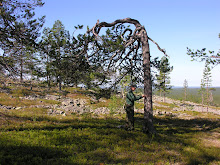Miina has already written about her visit to Connecticut for the Multitemp conference at the end of July. Actually, she was not alone in the US. We were traveling together from Helsinki to Boston and while Miina was visiting the town called Mystic, I was having a good time working on p and having lunches with prof. Ranga Myneni. A large part of justifying the transatlantic flight was to meet the Climate and Vegetation research group at Boston University.

Heat wave in Boston
Boston was hot and tropical, air conditioning in BU was fierce, and welcome was warm. Thus, it was good two weeks. Eventually, prof. Yuri Knyazikhin also arrived from Spain and during the second week the theme of the visit closed in on the spectral invariant, photon recollision probability, or just p for short.
 Discussions with Yuri. The photo is misleading: it is actually me who is at a loss, not Yuri. I manage to hide my confusion well, but this is (as I have heard) a common side effect of talking to Yuri about the eigenvalues
Discussions with Yuri. The photo is misleading: it is actually me who is at a loss, not Yuri. I manage to hide my confusion well, but this is (as I have heard) a common side effect of talking to Yuri about the eigenvaluesSpectral invariants: one of the hot spots of vegetation remote sensing. Everybody knows what they are, but I guess that only a few understand what they (or it, in case there is just one spectral invariant) mean. I have some publications on the subject, but why the spectral invariant approach works so well has remained a mystery to me. I understand the idea behind using the eigenvalue and why the radiation field should be reasonably well approximated by the first eigenvector. Still, sometimes points fall on the line with magical accuracy, and not just for canopy absorption, but also for reflectance.
The discussions we had with Yuri were fruitful, at least for me. I think I am a bit closer to some sort of an understanding. However, it will take some time before I can write this understanding down with sufficient accuracy.
There some other good things about traveling besides meeting interesting people. It is often about the little things, like having morning coffee and a croissant in Paris during a six-hour change at CDG. Some praise for such an opportunity has to go to the global recession: our original flight from Boston to Paris was canceled and we had to take an earlier one. Thus, what is usually considered a nuisance can be turned into a possibility -- to be in Paris before the tourists wake up, sit on a terrace of a boulangerie in the Latin quarter surrounded by a haze in the head created by the time difference watching Parisians cleaning the streets and opening up their businesses.
The jet lag, of course, had its revenge once we were back in Helsinki.




